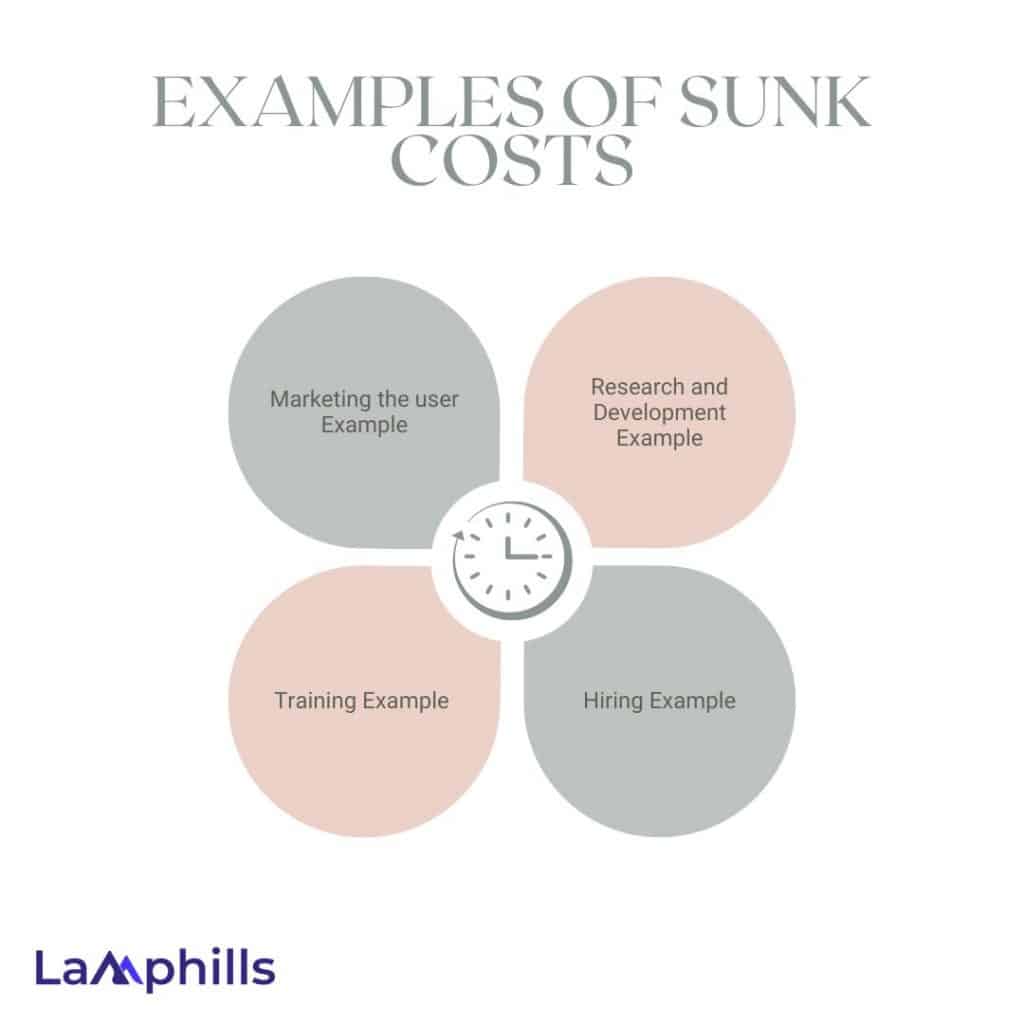Have you ever been riveted by something that didn’t work out as expected? A lot of us have been in this situation. Imagine spending millions on a new product and the launch fails or the product isn’t generating as much as you thought. This scenario, which is an example of sunk costs, is one of the pit bulls of business owners. Understanding sunk costs and how they affect your business and financial decisions can help you avoid costly mistakes. In this article, I am going to break down examples of the sunk cost fallacy and how to avoid it.
What Is the Sunk Cost?
Sunk cost, also called retrospective cost, is a cost that has occurred and cannot be gotten back, no matter what you do. The money for furnishing your office, the rent, money spent on ads and also money spent on new equipment or repairing equipment can be considered sunk cost. It is a cost that cannot be recovered even with additional spending or investment. I don’t know if you have heard of this quote that says, “ Don’t send good money chasing after bad It simply explains the situation of sunk cost.
An example of a sunk cost would be spending 2 billion naira on building a factory that is projected to cost 4 billion naira. The 2 billion naira already spent—the sunk cost—should not be taken into account when deciding whether the factory should be completed. What ought to matter instead are expectations of future costs and future returns once the factory is operational. Please note that opportunity cost is different from sunk cost.
Key Points
- Sunk costs are past expenses that cannot be recovered, such as money spent on office furnishings, rent, advertising, or equipment repairs. These costs should not influence future business decisions as they are irretrievable.
- This fallacy occurs when individuals or businesses continue investing in a failing project to justify the initial expense. An example is forcing oneself to use a gym membership because it’s paid for, despite not having time to go.
- To avoid the sunk cost fallacy, it is crucial to clearly define the problem to set a clear decision-making direction. It’s also important to avoid emotional attachment to decisions, as this can cloud judgment. Trusting data and excluding sunk costs from analysis helps make rational decisions based on future costs and benefits.
Examples of Sunk Costs
To understand sunk costs, it is helpful to relate them to life experiences. I will give 4 different examples using life experiences. They include:

#1. Marketing the user Example
Imagine you started a food delivery app in Nigeria and invested 2 million naira in developing an app feature that was supposed to improve user experience. After launching the feature, you realise it doesn’t work as expected and users aren’t responding positively. The 2 million naira you spent on this feature is a sunk cost—money that has already been spent and cannot be recovered, and it should not affect your decision on whether to continue investing in the app or try a different strategy.
#2. Research and Development Example
Let’s say you invest 8 million naira in launching a new clothing line. After the release, it turns out that customers are not interested in the new designs. The 8 million naira spent on production, marketing, and distribution is considered a sunk cost because it was a failed investment. Since you won’t be recovering this amount, it shouldn’t affect your future decisions regarding the clothing line.
#3. Training Example
Let’s say you own a store and you spend 10 million naira training your staff on how to use new inventory management software. After some time, you realize the software isn’t meeting your needs, and you decide to switch to a different software. This change requires you to train your employees again. The 10 million naira you initially spent on training is considered a sunk cost because it will never be recovered.
#4. Hiring Example
Let’s say you own a restaurant and spend 5 million naira renovating the interior to attract more customers. After completing the renovations, the business did not improve as expected. The 5 million naira spent on renovations is considered a sunk cost because it cannot be recovered and should not influence future business decisions.
What Is the Sunk Cost Fallacy?
Let’s say you paid 15,000 naira for a gym membership for a year. A few months in, you realize you rarely have time to go to the gym due to a busy work schedule. Although you should focus on other commitments, you force yourself to go to the gym just to make the most of the money you spend. This is an example of a sunk cost fallacy because you’re trying to justify the initial expense. The 15,000 naira you spent on the membership is a sunk cost, as it wouldn’t be recovered whether you went to the gym or not.
The sunk cost fallacy is simply trying to commit to a plan in order to justify it because resources have already been committed. The sunk fallacy in the example given above made you believe you were forcing yourself to go to the gym because you had already paid. In business, the sunk cost fallacy is prevalent when management refuses to deviate from original plans even when those original plans fail to generate income. If the investors are not careful, this sunk cost fallacy can make them make irrational decisions.
What Factors Lead To Sunk Cost Fallacy in Decision-Making?
There are many factors that can lead to sunk fallacies in decision-making. In this section, I will be explaining the three most common factors with examples. They include:
#1. Loss Aversion
Loss aversion, which is an example of a factor that leads to the sunk cost fallacy, is just when people are afraid to lose over an equivalent gain. For example, if you have a small business and have invested, say, 1,000,000 naira in a new product you are about to launch,. But during this project’s development, you realised that it was not as impactful as you wanted and that the project was likely a loss. Ideally, you should stop to avoid any further loss but since you have already invested 1,000,000 naira, which is the sunk cost, you will refuse to abandon the project. This refusal stems from loss aversion. So instead of abandoning the project, you kept on investing, hoping that it would eventually pay off. This decision is influenced by the desire to avoid the emotional pain of acknowledging an investment, even when stopping at that moment will prevent additional losses.
#2. Waste Avoidance
A lot of people have this strong desire to not waste the company’s resources, especially in areas where significant money, time, and effort have been spent. So let me explain waste avoidance, which is an example of a factor that leads to the sunk cost fallacy, using an example. So I heard about this pharmaceutical company that invested about 150,000,000 naira in new drug development.
After several years of research, the clinical trials indicated that the drug is not effective and will not be used. Ideally, the company should have halted that research immediately, but due to the invested time, money, and effort, they were finding it difficult to accept that the project had to be abandoned. Due to this mindset, they decided to add extra money to the research process, hoping to make it work finally. Despite the low likelihood of success, the desire to avoid wasting the initial investment leads them to continue spending company resources on a project with very little chance of a positive income.
#3. Personal decision-making
I have met a lot of people who are emotionally attached to decisions or specific projects assigned to them. This emotional attachment can be due to pride, professionalism, or a sense if responsibility. It is not always bad to be emotionally attached to your decisions; at least to some extent, it makes you work towards the decision. But where the problem comes in is when these emotions make you make biased decisions. This can lead to cloud judgment, making the individual believe that a struggling project will eventually turn around.
Just imagine yourself as a senior engineer at a tech company working on the development of software. You have dedicated countless hours to this project, from building a team to overcoming challenges like light failure in Nigeria. Now it’s time for analysis, and the testing indicates the software has flaws and is unlinked to succeed in a competitive market. As the senior engineer, you have this sense of responsibility towards the project and instead of backing down, you convinced the company to invest additional money and manpower into the project. Ultimately, the project fails, and all investment is lost. If you don’t control your emotional bias, it can prevent you from making rational decisions, leading to continued investment in a failing project.
Download our Post-Decision Review Checklist to evaluate and learn from your business decisions. This tool helps you reflect on the outcomes, assess the decision-making process, and identify areas for improvement to enhance future decision-making:
sunk cost.PDF
How to Avoid Sunk Cost Fallacy
Avoiding sunk cost fallacy depends on the fallacy committed but the list below explains the general way of avoiding sunk cost fallacy. They include:
#1. Frame the Problem
The first thing to do is to clearly identify the problem that needs to be solved. When you clearly define your problem, it sets a clear direction for the decision-making process. This prevents wasted efforts on minute issues that do not contribute to solving core problems. This approach helps to maintain clarity and direction and also aids in distinguishing between what is essential and what might be just a distraction.
#2. Remain Independent
You will lose your objectivity and overlook critical data and warning signs if you are overly emotionally invested in your decision-making. It is also important to note that just because the project is failing doesn’t mean the decision-maker is not doing a good job or is incompetent. It should be seen as an opportunity to learn and make better decisions for the future. Those Those who are emotionally invested in specific decisions do not make decisions based on data and evidence but rather hold onto the belief that their decisions will eventually pay off, despite evidence to the contrary. This unrealistic optimism can lead to further investment in failing businesses, causing more significant losses.
#3. Trust the Data
Most times, companies exclude sunk costs when doing analysis. Although it may feel absurd to disregard the money or resources already spent, this approach is logical and provides a more reliable basis for decision-making. Sunk costs represent past investments that cannot be recovered, so including them can cloud judgment and lead to decisions based on emotions rather than rational analysis. By focusing only on the future costs and benefits of each option, decision-makers can make choices that are aligned with current and future goals, free from the bias of past expenditures.
#4. Change Risk Preferences
One thing most investors do is pursue high-risk investments because they believe they bring high returns. They go as far as tolerating uncertainty in hopes of achieving significant gains. On the other hand, there are some investors who trade with caution. They prioritise the security and liquidity of their funds over potential growth, even if it means missing out on great opportunities that will bring returns.
For investors to grow and adapt, it’s essential to find a balance between these two approaches. By becoming more accepting of risk, investors can acknowledge that incurring sunk costs, which are expenditures that cannot be recovered, is a natural part of the investment journey. Recognizing this allows them to move beyond past losses and make decisions based on future opportunities rather than being paralyzed by the fear of risk.
Are Salaries a Sunk Cost?
Yes, any salary that has been paid to an employee is a sunk cost. As long as those wages are not recoverable, that salary represents an expense that has been incurred and can not be captured back by the company.
What Is a Sunk Cost vs. a Fixed Cost?
In business, fixed costs are expenses that have to be paid by a company independent of any specific work activities. They don’t apply to a company’s production of any goods or services, and they don’t rise or fall with a change in the number of goods or services produced or sold. Sunk costs are a subset of fixed costs—specifically, a type of fixed cost that is not recoverable.
What Is the Difference Between Sunk Cost and Relevant Cost?
When making business decisions, organizations should only consider relevant costs, which include future costs—such as decisions about inventory purchase costs or product pricing—that still need to be incurred. The relevant costs are contrasted with the potential revenue of one choice compared to another. Sunk costs are excluded from future business decisions because the cost will remain the same regardless of the outcome of the decision.
Conclusion
Whether you own a small business or a large one, the sunk cost and sunk cost fallacy, which I have explained using an example above, is very crucial for financial decisions. You should acknowledge that this cost exists and accept the fallacies it brings, rather than sticking to it and committing a sunk cost fallacy. Letting go of the past allows you to invest time, effort, and resources into ventures that promise better returns, ensuring a prosperous future for your business.
Related Articles
- How Much Do Instagram Ads Cost?
- WHAT IS SATELLITE MEDIA TOUR? Examples, Cost and Top Companies
- How Much Does Organic Content Cost? A Comprehensive Guide
- Content Websites Mistakes You Must Avoid (Learning These the Hard Way Cost Me $32k)






